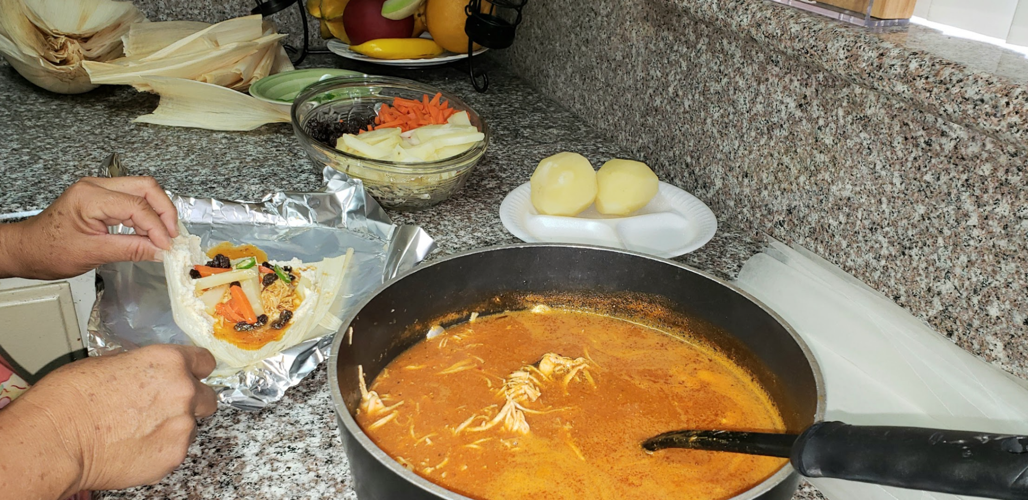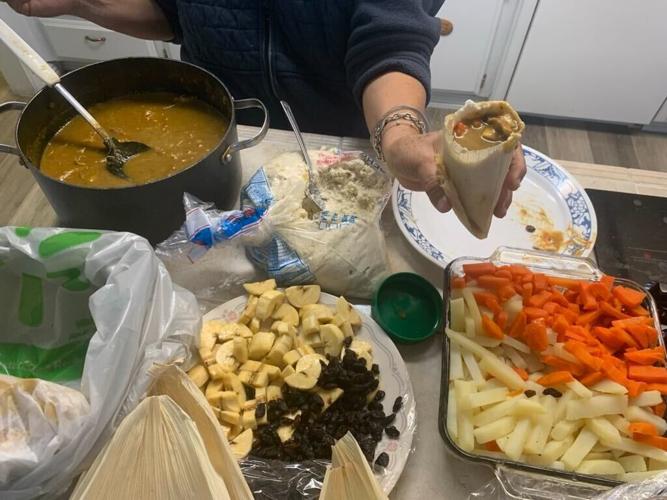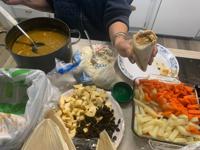
(Photo by Amairani Hernandez)
Get stories like these delivered straight to your inbox. Sign up for the CALÓ Newsletter.
For as long as I can remember, my mother has always made tamales during the Christmas season.
The best part is that one day I will be able to pass that tradition on to my own kids when they are old enough.
My mom likes to talk about the time she learned to make tamales.
“Yo recuerdo que cuando tenía nueve años me enseñaron hacer tamales porque mi familia y yo en México los vendíamos en la calle por un peso,” my mother, Isis Hernández, said she was nine years old when she learned to make tamales to sell.
For five years, my mother's job was tying tamales. “Normalmente hacíamos 300 tamales al día,” my mother said they made 300 tamales a day.
In Escuinapa, Sinaloa, traditional tamales are called 'barbones' because they are prepared with whole shrimp. They are known because the beard of the shrimp stands out from one side of the tamale. “Estos ricos tamales de camarones frescos y picadillo siempre han sido los tamales favoritos de la gente,”my mom said.
The tamales don't have vegetables, she said. They only consist of shrimp and when they are boiled, the tamale releases its juice, which greatly improves the flavor of the tamale.
Another important part of this tamale is that the dough is different, it is made with a browner dough. The special dough is called “nixtamal” made with corn and wheat flour.
In addition to making the famous Sinaloa tamales, my mom always makes her red chicken tamales. The good thing about these tamales is that they are not tied.
“Mis tamales de pollo rojos son americanizados, porque cuando vine a los Estados Unidos, los tamales de aquí eran doblados con la hoja del tamal y el papel encerado”, dijo mi mamá.
These tamales created by my mother have juicy chicken, raisins, carrots, potatoes and jalapeño.
We always make the tamales two days before Christmas. My mother and I got up at five in the morning so we could finish early. The entire process lasts more than four hours, depending on the quantity of tamales.
First, we cook the chicken and while the chicken is boiling, we cut all the vegetables. The first step lasts an hour.
The second step is when I put the dough on the leaves. This part can get a little complicated for first-timers.
The third step is putting the ingredients on the leaves. My mom and I make about 80 tamales and let me tell you at the end of our cooking session our, back hurts.
The fourth step is when my mother pours the chicken broth and wraps the tamales. The second, third and fourth steps last one hour.

Tamales Sinaloenses. (Photo by Amairani Hernandez)
The fifth step is to boil the tamales for two hours.
Finally, the last step is to make sure the tamales are ready to enjoy with a cup of champurrado.
The most important thing about this tradition is how my mother passed on to me the story of making tamales and selling them on the street.
Since I was young, she taught me how to be an honest and hard-working person. I have so many memories of us selling shoes, ice cream and of course her delicious tamales.
I can't wait until the day comes when I can do this with my own children, thanks to my ‘ama.











(0) comments
Welcome to the discussion.
Log In
Keep it Clean. Please avoid obscene, vulgar, lewd, racist or sexually-oriented language.
PLEASE TURN OFF YOUR CAPS LOCK.
Don't Threaten. Threats of harming another person will not be tolerated.
Be Truthful. Don't knowingly lie about anyone or anything.
Be Nice. No racism, sexism or any sort of -ism that is degrading to another person.
Be Proactive. Use the 'Report' link on each comment to let us know of abusive posts.
Share with Us. We'd love to hear eyewitness accounts, the history behind an article.